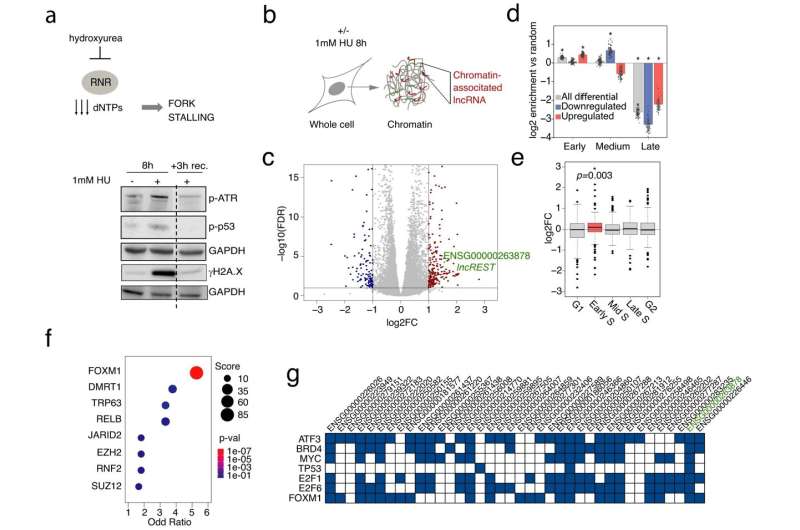This article has been reviewed according to Science X's editorial process and policies. Editors have highlighted the following attributes while ensuring the content's credibility:
fact-checked
peer-reviewed publication
proofread
Researchers discover an RNA molecule that could be used as a therapeutic target against cancer cells

Researchers at Cima Universidad de Navarra have discovered that a ribonucleic acid that does not contain information to make proteins (long non-coding RNA) plays a crucial role in signaling and repairing errors in DNA replication during cell division. This finding could lead to the development of new anti-tumor therapies.
Scientists have identified an RNA that they named "lncREST" (long non-coding RNA REplication STress) and uncovered its role in triggering an effective response to the stress induced by rapid cell division.
"LncREST localizes to chromatin (the structure in which DNA is organized in the cell). Its main function is to facilitate the localization of key proteins in the process of DNA replication and DNA damage repair where they are needed. In fact, the absence of lncREST has been shown to cause impaired stress signaling, leading to the accumulation of severe DNA defects and, ultimately, cell death," explains Luisa Statello Ph.D., first and co-corresponding author of the study.
"We have discovered that lncREST—controlled by the tumor suppressor p53—acts as a functional sensor. It ensures that the necessary proteins are in the right place at the right time and, that genome replication does not fail," says Maite Huarte, leader of the study and principal investigator of the Non-Coding RNA and Cancer Genome Group at Cima Universidad de Navarra.
The work, published in the journal Nature Communications, has not only revealed IncREST as a critical component of the stress response but could also be an effective therapeutic target in the fight against various types of cancer.
"This discovery is an important step towards a better understanding of how our cells deal with stress during cell division. In addition, it could open up a new avenue for studies to develop new therapies against cancer cells, or improve existing ones, using lncREST as a therapeutic target," says Statello.
The researchers, who carried out the study in colorectal cancer cells and in mouse tumor models, also highlight the promising scenario that may result from combining known inhibitors with lncREST inhibitors to achieve a greater therapeutic effect. "The findings may lead to a combination therapy to use fewer drugs and reduce toxicity to the patient. By using two inhibitors at the same time, the chances of tumor cells developing resistance to treatment are reduced," suggests Huarte.
In this study, the Cima researchers have reformulated an existing technology to detect RNA molecules in the replication process. "We have developed a methodology called iROND, which allows us to identify RNAs that are located specifically at the sites where DNA is replicating. In fact, that is how we detected lncREST associated with replication sites under stress conditions," says Luisa Statello.
More information: Luisa Statello et al, The chromatin-associated lncREST ensures effective replication stress response by promoting the assembly of fork signaling factors, Nature Communications (2024). DOI: 10.1038/s41467-024-45183-5



















